
18 AI agent examples transforming modern workflows
Discover how agentic AI can simplify your procurement process.

Ever wish your business could just… run itself? Enter AI agents, the smart, autonomous software systems that are changing how businesses operate. More than just fancy chatbots, AI agents are designed to observe, plan, and act to achieve specific goals, learning and adapting along the way.
In this article, we'll dive into practical AI agents examples, exploring the different types of agents and showcasing real-world applications across various business functions, including how they're revolutionizing procurement processes. Get ready to see how these intelligent teammates can transform your operations.
What are AI agents?
AI agents are autonomous software programs designed to perceive their environment, make decisions, and take actions to achieve specific goals, often learning and adapting over time. Unlike traditional automation tools that follow rigid, pre-programmed rules (think of an email auto-responder that only sends predefined messages), AI agents can handle dynamic and unpredictable situations. They can operate independently or as part of a larger system, processing huge amounts of data—both structured and unstructured—to provide more intelligent and flexible solutions.
These capabilities are often built upon various architectural frameworks, leading to different types of agents designed for specific problem-solving approaches, from simple reactions to complex planning and learning.
Believe it or not, you likely already use AI agents, from virtual assistants like Siri and Alexa, which personalize our daily routines, to more specialized applications in industries such as finance for fraud detection, healthcare for diagnostic support, and manufacturing for optimizing production lines. This adaptability and decision-making capability set them apart, allowing businesses to move beyond simple task repetition to truly intelligent automation.
Simple reflex agents
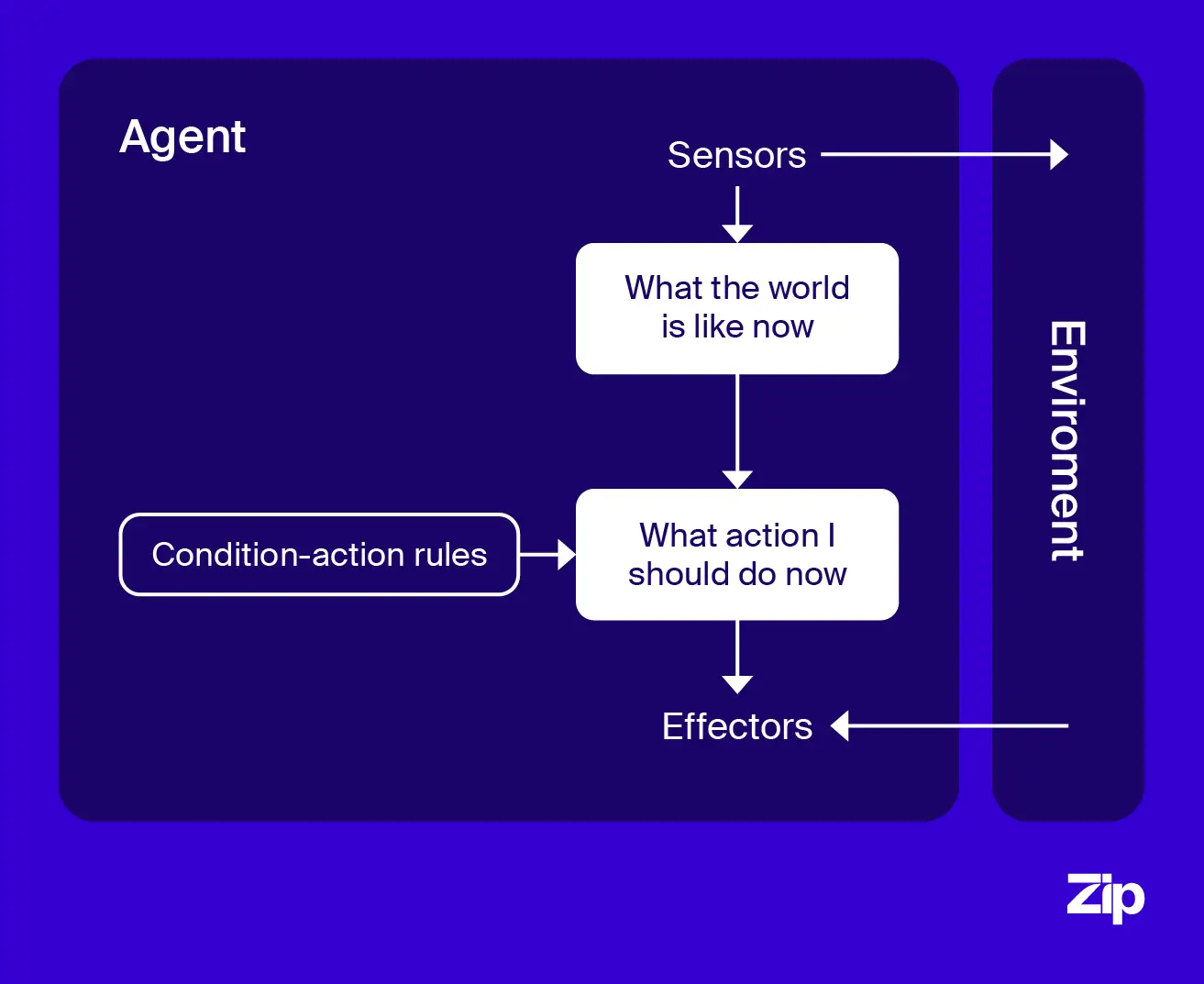
Simple reflex agents are the most basic type of AI agent. What defines them is their reliance on condition-action rules. This means they literally have a set of "if-then" statements: if a certain condition is met in their environment, then they perform a specific action. They're like a light switch—if it's dark, then turn on the light; if it's light, then turn it off.
Simple reflex agents have no memory of past events and no ability to plan for the future. They only consider their immediate perception of the environment.
1. GL coding assistants
Industry: Procurement, finance, accounting
A simple reflex AI agent type in the realm of general ledger (GL) coding could be an assistant that automatically assigns a specific GL account code to an expense based solely on a single, predefined keyword in the expense description.
For example, if the assistant encounters "office supplies" in an expense line item, it immediately and consistently assigns it to the "Office Supplies" GL account. It operates purely on this direct "if [keyword] then [GL code]" rule. It doesn't analyze the supplier, the amount, or any historical context of similar expenses; it simply reacts to that one keyword. This makes it efficient for high-volume, standardized transactions but limits its ability to handle nuanced or ambiguous expense descriptions.
2. Basic data validation agents
Industry: Procurement, information technology, finance, supply chain management, data management (virtually any industry that collects or processes data)
Basic data validation agents are AI agents designed to check if data inputs meet predefined rules or constraints, ensuring accuracy and consistency. Their primary function is to act as gatekeepers, flagging or rejecting data that doesn't conform.
In a procurement context, an example could be an agent in a supplier registration portal that automatically checks if the taxpayer identification number (TIN) or VAT number entered by a new supplier consists of the correct number of digits and adheres to a specific country's format.
Another instance might be an agent that verifies that a proposed purchase order's unit price for a specific item falls within an acceptable predefined range, or that a requested delivery date is not in the past. They operate on simple, often hard-coded rules to prevent common errors at the point of data entry, which is essential for maintaining clean and reliable procurement data.
3. Compliance review agents
Industry: Procurement, supply chain management, legal, finance, cybersecurity, risk management
Compliance review agents are AI programs designed to automatically check documents, transactions, or processes against a set of predefined regulatory rules and internal policies. In sourcing and procurement, these agents are super helpful for making sure everything aligns with legal and company requirements.
For instance, an agent might scan supplier contracts to ensure they include mandatory clauses related to data privacy (like GDPR) or cybersecurity standards, which is especially important under regulations like the Digital Operational Resilience Act (DORA) for financial entities.
These agents can also cross-reference a potential supplier against international sanctions lists or verify that all necessary certifications (e.g., ISO certifications for quality or environmental management) are present and valid before a contract is finalized, reducing legal and reputational risks.

Model-based reflex agents
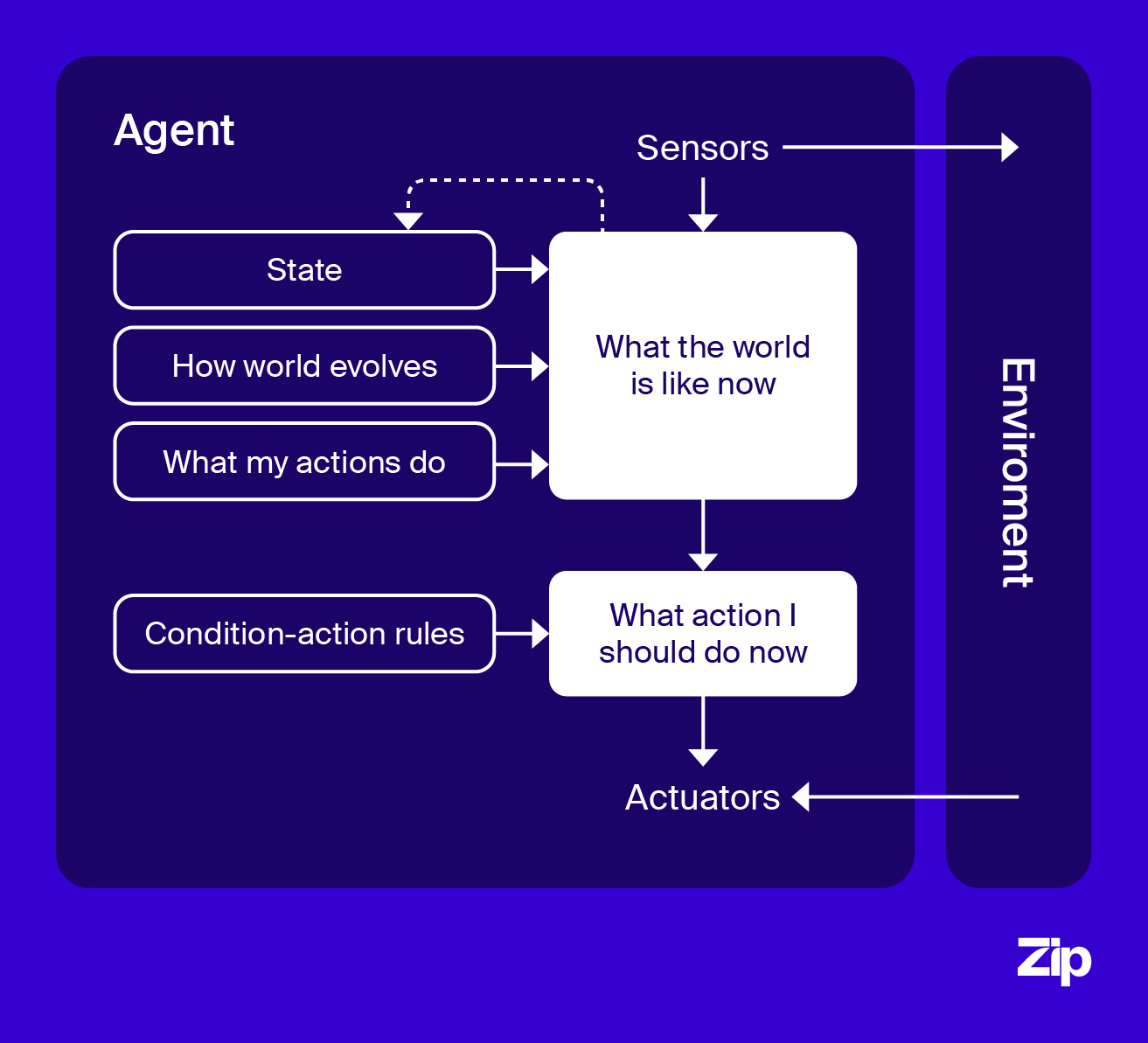
Model-based reflex agents are a step up from simple reflex agents because they don't just react to what they see right now. Instead, they build and maintain an internal "model" of their environment. This allows them to reason about situations that are only partially observable, meaning they don't have all the information directly in front of them.
Imagine a sophisticated inventory management system. A simple reflex agent might just reorder a product when stock hits a certain low point. A model-based reflex agent, however, would consider current stock levels but also factor in things it can't "see" directly, like upcoming marketing campaigns that will increase demand or known supplier delays. It uses its internal model of demand patterns, supply chain lead times, and promotional impacts to make more informed reordering decisions, even when it doesn't have a crystal ball.
4. Procurement intake platforms
Industry: Procurement, supply chain management, finance, information technology
Procurement intake platforms serve as the intelligent "front door" for all internal requests for goods and services. What makes them model-based is their ability to maintain an internal understanding of the procurement landscape.
For example, when an employee submits a request for a new laptop, the platform doesn't just see "laptop needed." Instead, it uses its internal model of company policies, preferred suppliers, existing contracts, budget allocations, and even current market conditions to understand the context of that request. It might automatically know that specific models from certain suppliers are pre-approved, or that a larger quantity order could trigger a volume discount.
Based on this internal model, it can then reflexively route the request to the correct approval chain, suggest a pre-negotiated catalog item, or even flag it for a strategic sourcing event if it's a significant new spend category. They don't need a human to explicitly tell them every rule for every scenario; they infer and apply the right actions based on their comprehensive understanding of the procurement environment.
5. Legal review agents
Industry: Procurement, legal, supply chain management, compliance, risk management
Legal review agents are designed to automate and intelligently assist with the complex task of reviewing legal documents, particularly in sourcing and procurement. Their internal understanding of legal principles, common contract clauses, and specific regulatory frameworks takes them a step up from simple reflex agents.
Procurement teams can leverage legal review agents when evaluating a new supplier contract. The agent won't just look for keywords. It has an internal model of what a standard procurement contract looks like, what clauses are typically required (e.g., indemnification, force majeure, intellectual property rights), and the legal implications of their absence or modification. It'll also understand relevant regulations like data privacy laws (e.g., GDPR, CCPA) or industry-specific compliance rules (e.g., those related to financial services or healthcare).
If it identifies a missing or problematic clause or a term that deviates significantly from best practices based on its internal model, it can flag it for human review, suggest alternative language, or even automatically generate a redline version for negotiation.
6. Contract compliance agents
Industry: Procurement, supply chain management, legal, finance, operations, risk management
As model-based reflex agents, contract compliance agents are all about making sure that once a contract is signed, both your organization and the supplier actually stick to the agreed-upon terms throughout the contract's lifecycle. They build an internal model of the contract's specific obligations, key performance indicators (KPIs), service level agreements (SLAs), pricing structures, and reporting requirements.
For example, if a procurement contract states a supplier must deliver goods within 48 hours and provide weekly performance reports, the compliance agent would automatically track delivery times from shipping notifications and check for the timely submission and content of those reports. If the agent's internal model detects a deviation—like a delivery taking 72 hours or a report missing key data—it flags the issue, potentially triggering an alert to the procurement manager or even initiating a penalty clause if the contract allows.
Utility-based agents
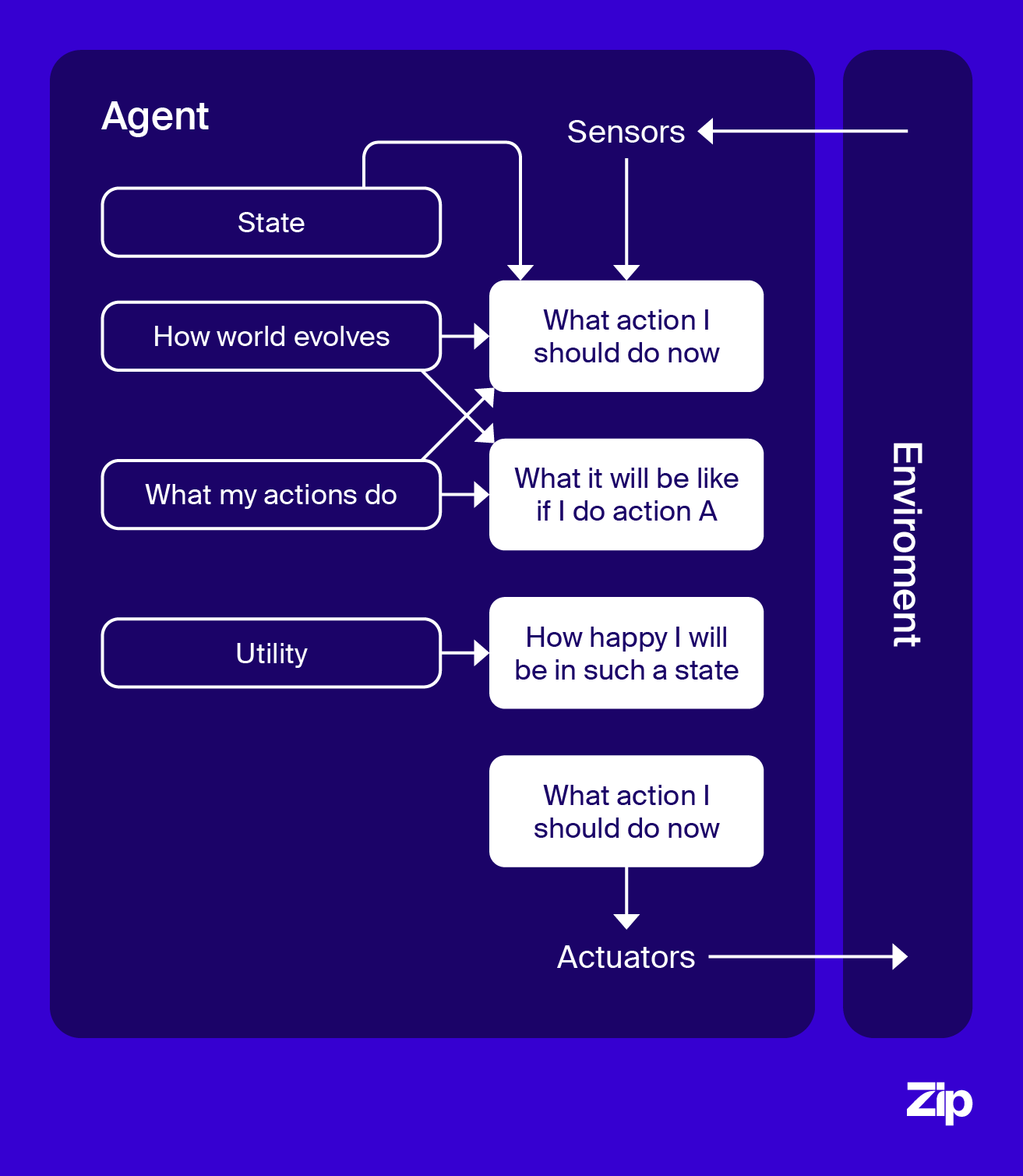
Utility-based agents are an advanced type of AI agent that really shines when decisions aren't black and white. What sets them apart is their use of a utility function—think of it as a scoring system or a personalized preference map that tells the agent how "good" or "desirable" any given outcome is.
Instead of just trying to achieve a single goal, these agents evaluate all the possible actions they could take and then calculate the "utility" of each potential outcome. They then choose the action that promises the highest overall utility. This approach is particularly powerful because it allows them to balance complex trade-offs across multiple factors.
7. Pricing and payment terms optimization
Industry: Procurement, supply chain management, manufacturing, retail, finance
A utility-based agent for pricing and payment terms optimization is like having a negotiator that balances all your priorities. Instead of just trying to get the lowest price or the quickest payment, this agent uses a sophisticated utility function that weighs various factors important to the business.
For example, when a procurement team is negotiating a bulk purchase of raw materials, the agent might analyze not only the quoted price but also the supplier's historical on-time delivery rate, quality control metrics, and proposed payment terms.
Based on its utility function, which might prioritize just-in-time inventory and high-quality inputs over a marginal price reduction, it could suggest accepting a slightly higher per-unit price from a supplier known for exceptional reliability and shorter lead times, rather than choosing the cheapest option with a history of delays. It's constantly balancing these trade-offs to arrive at the option that provides the highest "score" according to the business's defined purchasing objectives.
8. RFP-related agents
Industry: Procurement, sales, business development, professional services, consulting, technology, government contracting
Request for proposal (RFP)-related agents play a valuable role in determining the most advantageous approach to winning a specific supplier contract. Their utility function considers various elements like the probability of winning the RFP, the potential profitability of the project, the strategic value of the client, the resources required to complete the proposal, and even how well the project aligns with the company's long-term goals.
For instance, when a company receives an RFP, the agent will analyze not just the client's budget and the scope of work, but also the company's existing workload, the strength of their competitive offering for this particular project, and the potential for a positive reputational impact. It might suggest submitting a highly detailed, customized proposal for a strategically important client even if the immediate profit margin is slightly lower, because the long-term utility (e.g., future business, market share) is higher.
On the other hand, for an RFP with low strategic value and high resource demands, it might recommend a more standardized, less effort-intensive response, or even advise against bidding entirely, all based on optimizing its internal utility score.
9. Negotiation advice agents
Industry: Procurement, finance, sales, supply chain management, legal
A negotiation advice agent is like having an expert negotiator constantly whispering in your ear during a deal. This agent has a "scorecard" (its utility function) that it uses to evaluate every possible move. Instead of just telling you to aim for the lowest price, it helps you see the bigger picture so you can make smarter trade-offs.
For example, in procurement, when negotiating with a supplier for new equipment, the agent might weigh the upfront cost as well as the supplier's reliability, the warranty length, delivery speed, and even the strategic importance of building a good relationship with that specific supplier for future deals.
In a financial setting, like negotiating loan terms, it could balance the interest rate against the repayment schedule, fees, and the overall impact on cash flow. The agent's goal is to find the combination of terms that gives your company the best overall "score," even if that means accepting a slightly higher price in exchange for better service or more flexible payment terms.
Learning agents
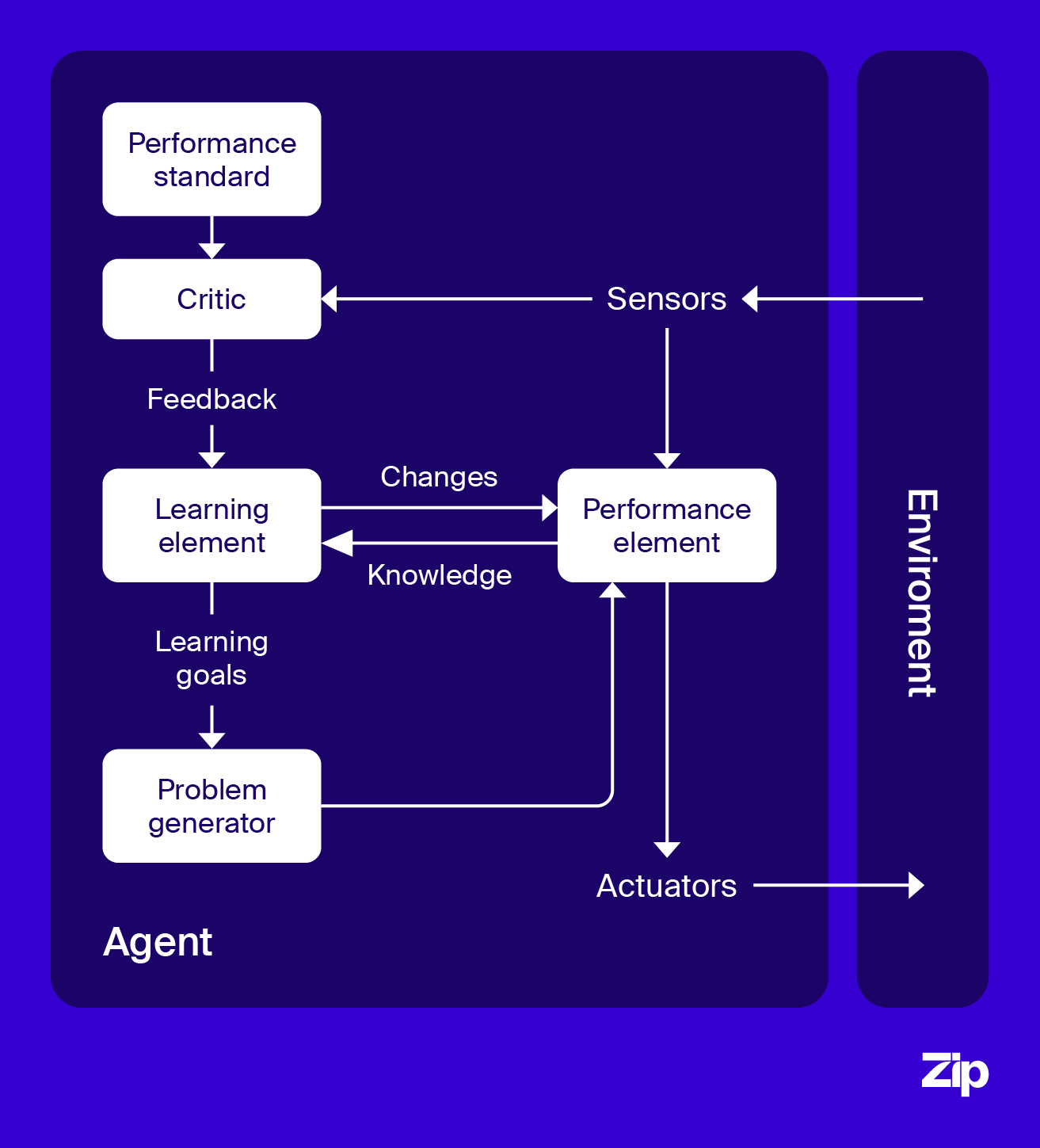
Unlike some of the other types of AI agents, learning agents aren't stuck with what they initially know. They're able to improve over time by learning from experience and new data. Think of them like a human who practices a skill or studies for a test—the more they do it, the smarter and more effective they become.
This continuous improvement means they can adapt their behavior over time as the world around them changes or as they encounter new situations. They're built to evolve and become more intelligent on their own.
10. Vendor risk tiering agents
Industry: Procurement, supply chain management, risk management, finance, cybersecurity
Vendor risk tiering agents are a type of learning agent designed to continually refine how they categorize suppliers based on their risk level. They might initially operate based on preset rules, but their real potential comes from learning through experience.
In a sourcing setting, imagine an agent that starts by labeling new vendors as "high," "medium," or "low" risk based on simple criteria like their industry and financial stability. However, over time, as it processes more data—like actual supplier performance, audit results, security incidents, compliance breaches, or even news mentions—it starts to learn more nuanced patterns.
If a "low-risk" supplier consistently experiences cyberattacks or delivery delays, the agent will learn from this feedback. It will then automatically adjust its internal model, perhaps re-tiering that supplier to a "medium" or "high" risk and applying this new understanding to similar future suppliers. This allows the agent to get smarter and more accurate at assessing vendor risk without constant human intervention, adapting its behavior as real-world data rolls in.
11. Fraud detection agents
Industry: Procurement, finance, banking, e-commerce, insurance, cybersecurity, retail
Fraud detection agents are classic examples of learning agents because they continuously get better at spotting suspicious activity. They start by being trained on past transaction data, learning what "normal" behavior looks like. But fraudsters are always finding new tricks, so these agents can't stay static.
When a new transaction comes in, the agent analyzes it against its learned understanding of normal patterns. If a transaction deviates significantly—say, a purchase made at an unusual time or location for a customer, or an amount much larger than their typical spending—the agent flags it.
When human analysts confirm whether a flagged transaction was actually fraudulent or not, that feedback is fed back into the agent. This allows the agent to learn from its mistakes and successes, adapting its internal model to recognize new fraud patterns and improve its accuracy over time. It's a continuous cycle of prediction, feedback, and refinement.
12. Financial due diligence agents
Industry: Procurement, finance, investment banking, private equity, mergers and acquisitions, accounting, venture capital
Financial due diligence agents are constantly improving their ability to assess the financial health and risks of a company, which is a huge benefit for businesses looking to make smart investments or acquisitions. They start by analyzing vast amounts of financial data—like balance sheets, income statements, cash flow reports, and market trends—to learn what "healthy" or "risky" financial patterns look like across different industries.
When a new company is being considered for an investment or partnership, the agent can quickly sift through its financial records and compare them to its learned models. If it spots anomalies, unusual spending, or financial ratios that deviate from what it has learned is normal for similar businesses, it will flag them for human review.
As human financial experts provide feedback on the agent's findings—confirming whether a flagged item was indeed a concern or a false alarm—the agent learns from these outcomes, refining its ability to identify subtle financial red flags and provide more accurate risk assessments over time.
Hierarchical agents
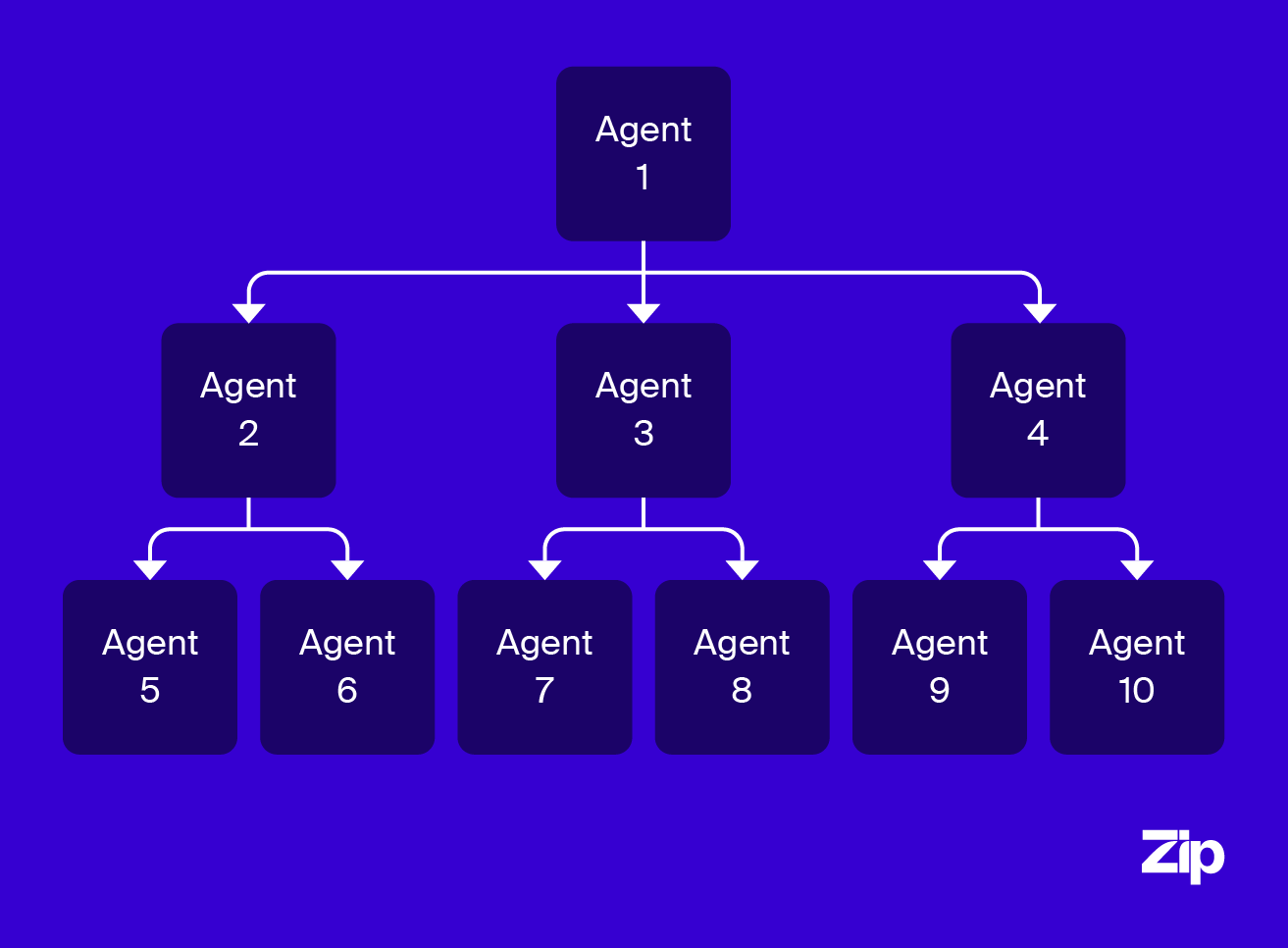
Hierarchical agents are like the middle managers of the AI world. What makes them unique is their multi-layered structure, with decision-making happening at various levels. Instead of one big brain trying to figure everything out, they break down a large, complex problem into smaller, more manageable pieces. There's usually a "higher-level" agent that focuses on the big picture—setting the overall strategy and defining broad goals.
Then, there are "lower-level" agents that report to the higher-level ones, each responsible for specific, individual tasks. These lower-level agents carry out the detailed work needed to achieve the broader goals set by the top. This layered approach allows them to coordinate broad strategy with individual tasks, making them ideal for tackling highly complex problems that require both strategic oversight and detailed execution.
13. Security review agents
Industry: Procurement, cybersecurity, information technology, finance, healthcare, government, any industry with significant digital assets
Security review agents bring a structured and comprehensive approach to safeguarding a business's digital assets. Imagine a top-level agent overseeing the entire cybersecurity posture, defining broad strategies like "ensure compliance with all data privacy regulations" or "protect against advanced persistent threats." This high-level agent doesn't get into the nitty-gritty, but rather delegates.
Below it, you'd have specialized agents handling specific domains: One might focus solely on network security, looking for unusual traffic patterns, another on application security, scanning code for vulnerabilities, and a third one on compliance, checking configurations against industry standards. Each lower-level agent executes its specific checks and reports back.
If a network agent detects anything suspicious, it reports to the higher-level agent, which then decides on the overall response, potentially coordinating with other agents to isolate the threat or initiate a broader investigation. This layered approach ensures security is strategically managed and thoroughly executed at every level.
14. Advanced data validation agents
Industry: Procurement, information technology, data management, finance, healthcare, retail, marketing, virtually any industry that relies on accurate data
Advanced data validation agents go way beyond what simple reflex agents can do by bringing multiple layers of intelligence to ensure data quality. A basic data validation agent (a simple reflex agent) might just check if an email address has an "@" symbol. But an advanced one operates with a "boss" agent overseeing the overall data quality goal, like "ensure all customer data is accurate and consistent across systems."
This top agent then directs specialized "worker" agents. One worker might verify the email format, another could cross-reference the customer's address with a postal database for accuracy, and a third might check if the phone number is active and corresponds to the provided location.
If an inconsistency is found (e.g., the address doesn't match the city), the higher-level agent evaluates the discrepancy and decides how to handle it—perhaps flagging it for human review, attempting an automated correction based on other verified data points, or even initiating a data enrichment process.
15. Industrial automation agents
Industry: Manufacturing, automotive, logistics, energy, robotics
Industrial automation agents, when designed as hierarchical agents, bring sophisticated control to factories and production lines. A top-level agent might manage the entire production schedule, deciding which products to make and when.
This broad strategy is then broken down: Middle-level agents could oversee specific assembly lines, ensuring efficiency, while the lowest-level agents directly control individual robotic arms or machinery to perform precise tasks like welding or packaging.
This layered approach ensures that the overall production plan is followed to a tee, with each level managing its part. This helps businesses increase production speed, reduce human errors, and make manufacturing much more efficient and reliable.
Multi-agent systems
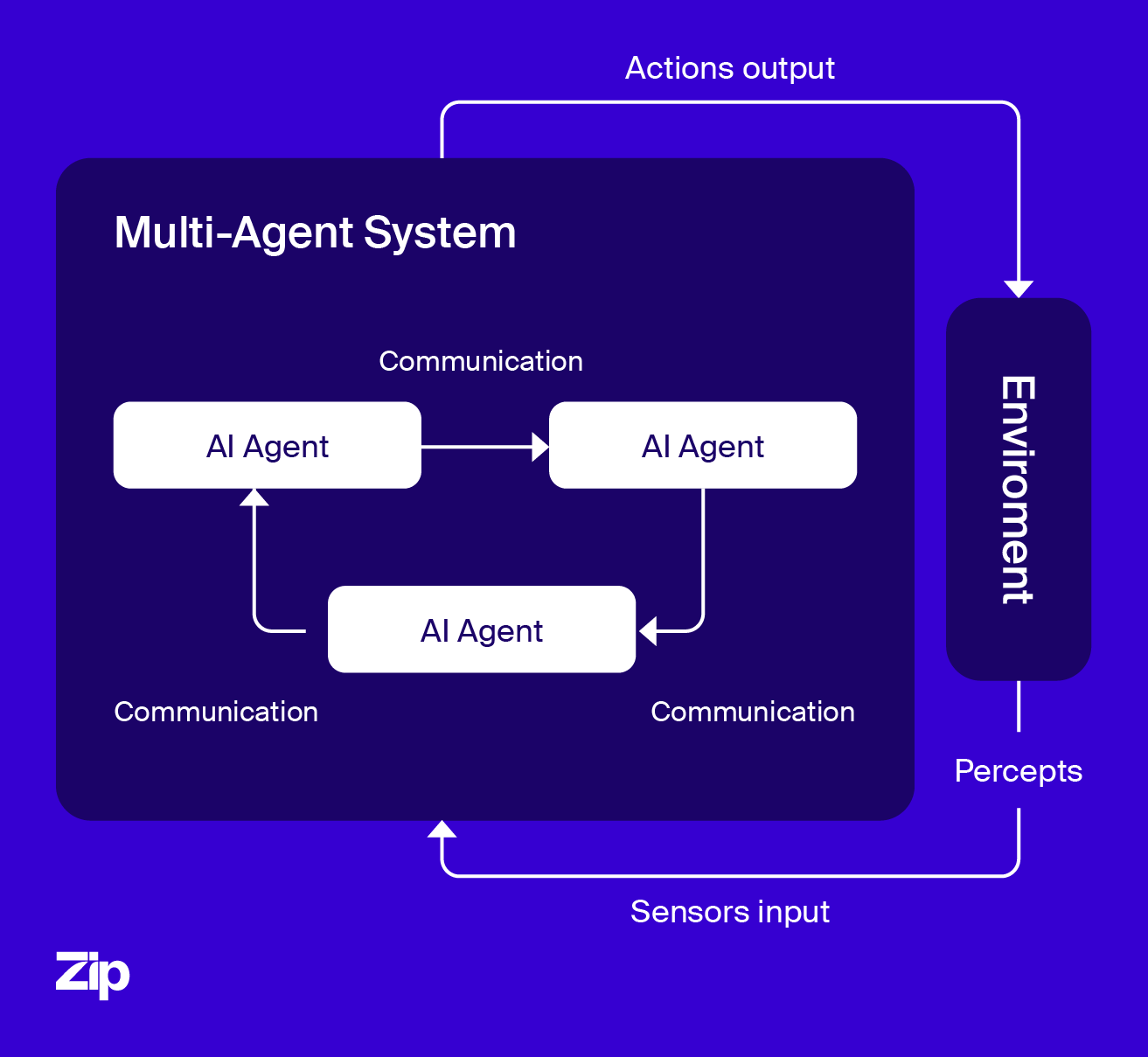
Multi-agent systems are a distinct category because they involve networks of multiple, individual AI agents all working together to solve a larger, more complex problem. Unlike a single, powerful AI, these systems are made up of several smaller, specialized agents, each with its own capabilities and goals but designed to coordinate with each other. Think of it like a well-organized team; each team member (agent) handles a specific part of the challenge, communicating and collaborating to achieve a common objective.
This collaborative nature makes them incredibly useful in complex, distributed systems where information is spread out, or where different parts of a problem need to be handled simultaneously by different specialists.
16. End-to-end procurement automation
Industry: Procurement, supply chain management, finance, manufacturing, retail
As a multi-agent system, end-to-end procurement automation involves various specialized AI agents collaborating to manage the entire purchasing process from start to finish. Instead of one huge system, you have individual agents, each handling a specific part.
For instance, one agent might be a request agent that helps employees create purchase requisitions, automatically checking budgets. Then, a sourcing agent finds suitable suppliers and negotiates prices, working with a contract agent that ensures legal terms are met. Once approved, a purchase order agent issues the order, and later, an invoice agent matches invoices to received goods and manages payments.
These agents constantly talk to each other, sharing information and triggering the next step seamlessly. This collaborative network dramatically speeds up the entire procurement cycle, reduces manual errors, ensures compliance, and ultimately saves businesses a lot of time and money by making purchasing incredibly efficient.
17. Supplier risk monitoring
Industry: Procurement, supply chain management, risk management, manufacturing, retail, finance
Agentic supplier risk monitoring systems are made up of specialized AI agents constantly keeping an eye on the health and reliability of a company's suppliers. Instead of a single system trying to do everything, individual agents focus on different risk areas and share their findings.
One financial agent might track a supplier's credit ratings and public financial statements. Simultaneously, a geopolitical agent could monitor news and events in the supplier's operating regions for political instability or natural disasters. A cybersecurity agent might check for data breaches or vulnerability alerts related to that supplier, while a performance agent tracks on-time delivery rates and quality metrics from internal data. These agents continuously collect and analyze their specific data, then communicate and compare their insights.
If one agent detects a potential problem, it alerts the others, allowing the system to form a comprehensive risk picture and flag serious issues for human intervention. This setup helps businesses proactively identify and mitigate supply chain disruptions, ensuring continuity and protecting their reputation.
18. Invoice-to-pay (I2P) process automation
Industry: Procurement, finance, accounting, supply chain management, retail, manufacturing
Automating the entire invoice-to-pay process typically involves a clever system of multiple AI agents working together. You'd have one agent specialized in reading and extracting details from incoming invoices, another acting as a "matcher" to ensure those details line up with purchase orders and goods received, and perhaps a third handling approvals by flagging anything unusual or routing it to the right person.
Once everything checks out, a payment agent takes over to process the actual transfer. This collaborative network drastically cuts down on manual work, speeds up how quickly suppliers get paid, slashes errors, and reduces the risk of fraud. For businesses, this means smoother financial operations, better cash flow management, and clear visibility into their spending.
AI agents in procurement
AI agents are quickly changing the game for how businesses buy goods and services. Here's a closer look at what AI agents can do in procurement:
- Intake orchestration: AI agents automatically route incoming purchase requests to the right department or person, identify any missing information, and classify how urgent or important the request is.
- Supplier discovery and onboarding: AI can quickly scan huge global supplier databases to find and match the best vendor based on specific needs, how fast they can deliver, or their risk profile.
- RFx creation and optimization: AI agents can help draft RFPs, automatically collect bids from suppliers, and even score their responses based on your company's most important goals.
- Invoice and spend auditing: They can compare invoices against purchase orders in real time, immediately flagging any mismatches or instances where company policies might be violated.
- Tail spend management: AI agents excel at automating those low-value but high-volume purchases that often take a lot of manual effort.
- Supplier performance and risk monitoring: These agents can pull together risk data from various sources, keep an eye on how well suppliers are meeting their contract goals (KPIs), and send alerts if their performance isn't as expected.
How Zip helps streamline your procurement workflows
The evolution of AI agents is transforming procurement, and Zip is at the forefront of delivering these advanced capabilities to your business. This AI-powered intake and orchestration platform does more than just automate—it intelligently streamlines your entire buying process.
By leveraging smart, model-based logic, Zip can automatically classify and route purchase requests, accelerating approvals across all departments and eliminating bottlenecks. This gives you better control and visibility, making it easy to use preferred vendors, which cuts down on unapproved spending and boosts consistency. Plus, Zip connects seamlessly with your existing systems, providing end-to-end visibility into all your procurement activities.
Ready to see how Zip can revolutionize your procurement? Explore more about our cutting-edge platform and schedule a demo to see these benefits in action.

Maximize the ROI of your business spend

Enter your business email to keep reading


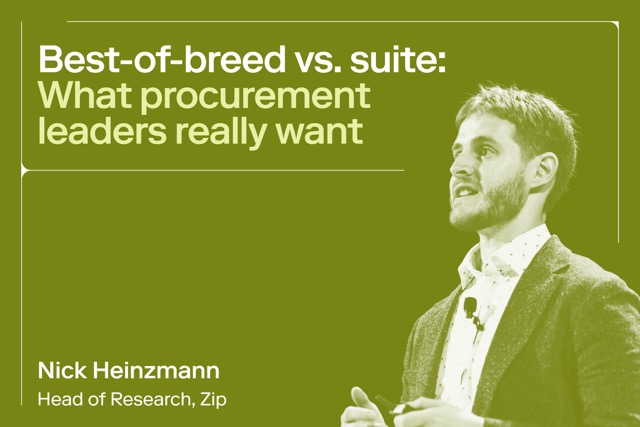
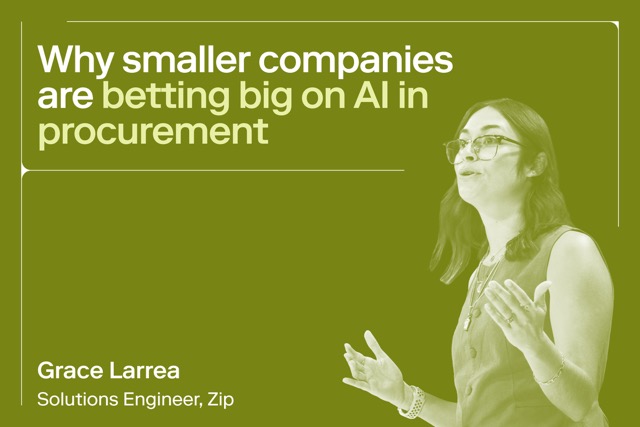


.webp)





